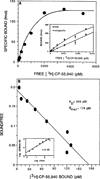Identification of a functionally relevant cannabinoid receptor on mouse spleen cells that is involved in cannabinoid-mediated immune modulation
- PMID: 1279376
- PMCID: PMC3657723
Identification of a functionally relevant cannabinoid receptor on mouse spleen cells that is involved in cannabinoid-mediated immune modulation
Abstract
Extensive behavioral and biochemical characterization of cannabinoid-mediated effects on the central nervous system has revealed at least three lines of evidence supporting the role of a putative guanine nucleotide-binding protein-coupled cannabinoid receptor for cannabimimetic effects, (i) stereoselectivity, (ii) inhibition of the adenylate cyclase/cAMP second messenger system, and (iii) radioligand-binding studies with the synthetic cannabinoid [3H]CP-55,940 indicating a high degree of specific binding to brain tissue preparations. Based on recent findings from our laboratory demonstrating that delta 9-tetrahydrocannabinol markedly inhibited forskolin-stimulated cAMP accumulation in mouse spleen cells, the presence of a guanine nucleotide-binding protein-coupled cannabinoid receptor associated with mouse spleen cells and its functional role in immune modulation were investigated. In the present studies, stereoselective immune modulation was observed with the synthetic bicyclic cannabinoid (-)-CP-55,940 versus (+) CP-56,667 and with 11-OH-delta 8-tetrahydrocannabinol-dimethylheptyl, (-)-HU-210 versus (+)-HU-211. In both cases, the (-)-enantiomer demonstrated greater immunoinhibitory potency than the (+)-isomer, as measured by the in vitro sheep red blood cell antibody-forming cell response. Radioligand binding studies produced a saturation isotherm exhibiting approximately 45-65% specific binding to mouse spleen cells. Scatchard analysis demonstrated a single binding site on spleen cells, possessing a Kd of 910 pM and a Bmax of approximately 1000 receptors/spleen cell. RNA polymerase chain reaction of isolated splenic RNA using specific primers for the cannabinoid receptor resulted in the amplification of a 854-kilobase predicted product that hybridized with cannabinoid receptor cDNA, demonstrating the presence of cannabinoid receptor mRNA in mouse spleen. Together, these findings strongly support the role of a cannabinoid receptor in immune modulation by cannabimimetic agents.
Figures




Similar articles
-
Cannabinoid receptors CB1 and CB2: a characterization of expression and adenylate cyclase modulation within the immune system.Toxicol Appl Pharmacol. 1997 Feb;142(2):278-87. doi: 10.1006/taap.1996.8034. Toxicol Appl Pharmacol. 1997. PMID: 9070350
-
Suppression of the humoral immune response by cannabinoids is partially mediated through inhibition of adenylate cyclase by a pertussis toxin-sensitive G-protein coupled mechanism.Biochem Pharmacol. 1994 Nov 16;48(10):1899-908. doi: 10.1016/0006-2952(94)90588-6. Biochem Pharmacol. 1994. PMID: 7986201
-
Determination and characterization of a cannabinoid receptor in rat brain.Mol Pharmacol. 1988 Nov;34(5):605-13. Mol Pharmacol. 1988. PMID: 2848184
-
Inhibition of the cAMP signaling cascade via cannabinoid receptors: a putative mechanism of immune modulation by cannabinoid compounds.Toxicol Lett. 1998 Dec 28;102-103:59-63. doi: 10.1016/s0378-4274(98)00284-7. Toxicol Lett. 1998. PMID: 10022233 Review.
-
Cannabinoid receptors and their endogenous agonists.Annu Rev Pharmacol Toxicol. 1998;38:179-200. doi: 10.1146/annurev.pharmtox.38.1.179. Annu Rev Pharmacol Toxicol. 1998. PMID: 9597153 Review.
Cited by
-
Role of cannabinoid CB1 receptors and tumor necrosis factor-alpha in the gut and systemic anti-inflammatory activity of SR 141716 (rimonabant) in rodents.Br J Pharmacol. 2003 Sep;140(1):115-22. doi: 10.1038/sj.bjp.0705412. Epub 2003 Jul 29. Br J Pharmacol. 2003. PMID: 12967941 Free PMC article.
-
Emerging role of the cannabinoid receptor CB2 in immune regulation: therapeutic prospects for neuroinflammation.Expert Rev Mol Med. 2009 Jan 20;11:e3. doi: 10.1017/S1462399409000957. Expert Rev Mol Med. 2009. PMID: 19152719 Free PMC article. Review.
-
UPLC-MS/MS Method for Analysis of Endocannabinoid and Related Lipid Metabolism in Mouse Mucosal Tissue.Front Physiol. 2021 Jul 14;12:699712. doi: 10.3389/fphys.2021.699712. eCollection 2021. Front Physiol. 2021. PMID: 34335305 Free PMC article.
-
Influence of rimonabant treatment on peripheral blood mononuclear cells; flow cytometry analysis and gene expression profiling.PeerJ. 2015 Jun 30;3:e1056. doi: 10.7717/peerj.1056. eCollection 2015. PeerJ. 2015. PMID: 26157624 Free PMC article.
-
Direct suppression of autoreactive lymphocytes in the central nervous system via the CB2 receptor.Br J Pharmacol. 2008 Jan;153(2):271-6. doi: 10.1038/sj.bjp.0707493. Epub 2007 Oct 8. Br J Pharmacol. 2008. PMID: 17922025 Free PMC article. Review.
References
-
- Munson AE, Fehr KO. Immunological effects of cannabis. In: Fehr KO, Kalant H, editors. Adverse Health and Behavioral Consequences of Cannabis Us. Addiction Research Foundation; 1983. pp. 257–353.
-
- Matsuda LA, Lolait SJ, Brownstein MJ, Young AC, Bonner TI. Structure of a cannabinoid receptor and functional expression of the cloned cDNA. Nature (Lond.) 1990;346:561–564. - PubMed
-
- Howlett AC, Johnson MR, Melvin LS, Milne GM. Nonclassical cannabinoid analgetics inhibit adenylate cyclase: development of a cannabinoid receptor model. Mol. Pharmacol. 1988;23:297–302. - PubMed
-
- Devane WA, Dysarz FA, Johnson MR, Melvin LS, Howlett AC. Determination and characterization of a cannabinoid receptor in rat brain. Mol. Pharmacol. 1988;34:605–613. - PubMed
-
- Little PJ, Compton DR, Johnson MR, Melvin LS, Martin BR. Pharmacology and stereoselectivity of structurally novel cannabinoids in mice. J. Pharmacol. Exp. Ther. 1988;247:1046–1051. - PubMed
Publication types
MeSH terms
Substances
Grants and funding
LinkOut - more resources
Full Text Sources
Miscellaneous
